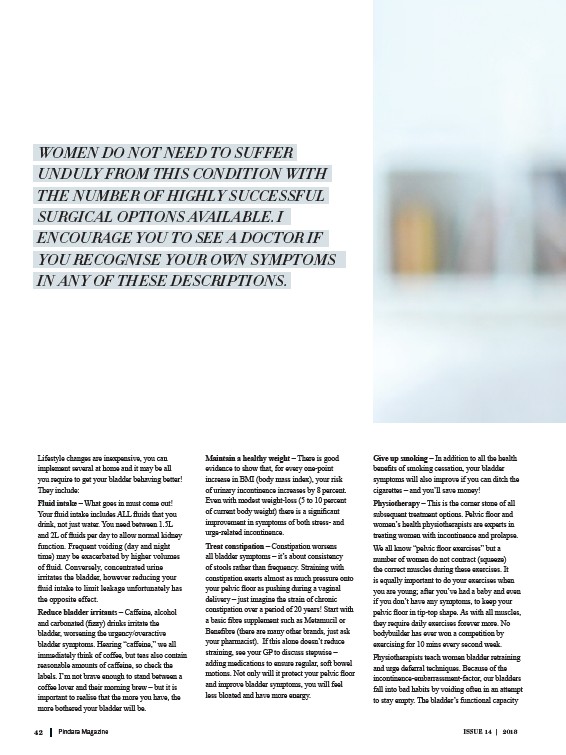
WOMEN DO NOT NEED TO SUFFER
UNDULY FROM THIS CONDITION WITH
THE NUMBER OF HIGHLY SUCCESSFUL
SURGICAL OPTIONS AVAILABLE. I
ENCOURAGE YOU TO SEE A DOCTOR IF
YOU RECOGNISE YOUR OWN SYMPTOMS
IN ANY OF THESE DESCRIPTIONS.
Lifestyle changes are inexpensive, you can
implement several at home and it may be all
you require to get your bladder behaving better!
They include:
Fluid intake – What goes in must come out!
Your fluid intake includes ALL fluids that you
drink, not just water. You need between 1.5L
and 2L of fluids per day to allow normal kidney
function. Frequent voiding (day and night
time) may be exacerbated by higher volumes
of fluid. Conversely, concentrated urine
irritates the bladder, however reducing your
fluid intake to limit leakage unfortunately has
the opposite effect.
Reduce bladder irritants – Caffeine, alcohol
and carbonated (fizzy) drinks irritate the
bladder, worsening the urgency/overactive
bladder symptoms. Hearing “caffeine,” we all
immediately think of coffee, but teas also contain
reasonable amounts of caffeine, so check the
labels. I’m not brave enough to stand between a
coffee lover and their morning brew – but it is
important to realise that the more you have, the
more bothered your bladder will be.
Maintain a healthy weight – There is good
evidence to show that, for every one-point
increase in BMI (body mass index), your risk
of urinary incontinence increases by 8 percent.
Even with modest weight-loss (5 to 10 percent
of current body weight) there is a significant
improvement in symptoms of both stress- and
urge-related incontinence.
Treat constipation – Constipation worsens
all bladder symptoms – it’s about consistency
of stools rather than frequency. Straining with
constipation exerts almost as much pressure onto
your pelvic floor as pushing during a vaginal
delivery – just imagine the strain of chronic
constipation over a period of 20 years! Start with
a basic fibre supplement such as Metamucil or
Benefibre (there are many other brands, just ask
your pharmacist). If this alone doesn’t reduce
straining, see your GP to discuss stepwise –
adding medications to ensure regular, soft bowel
motions. Not only will it protect your pelvic floor
and improve bladder symptoms, you will feel
less bloated and have more energy.
Give up smoking – In addition to all the health
benefits of smoking cessation, your bladder
symptoms will also improve if you can ditch the
cigarettes – and you’ll save money!
Physiotherapy – This is the corner stone of all
subsequent treatment options. Pelvic floor and
women’s health physiotherapists are experts in
treating women with incontinence and prolapse.
We all know “pelvic floor exercises” but a
number of women do not contract (squeeze)
the correct muscles during these exercises. It
is equally important to do your exercises when
you are young; after you’ve had a baby and even
if you don’t have any symptoms, to keep your
pelvic floor in tip-top shape. As with all muscles,
they require daily exercises forever more. No
bodybuilder has ever won a competition by
exercising for 10 mins every second week.
Physiotherapists teach women bladder retraining
and urge deferral techniques. Because of the
incontinence-embarrassment-factor, our bladders
fall into bad habits by voiding often in an attempt
to stay empty. The bladder’s functional capacity
42 Pindara Magazine ISSUE 14 | 2018